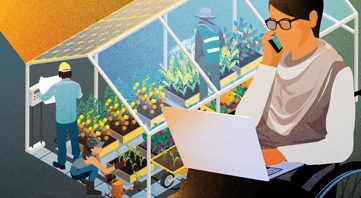Introduction
This year’s report is entitled “Work in Transition” not because (or not only because) it studies work in the EBRD’s countries of operations that are in transition to sustainable market economies. “Work in Transition” is first and foremost about the transformation that is happening to work itself – both in advanced economies and emerging markets.
Foreword
This year’s report is entitled “Work in Transition” not because (or not only because) it studies work in the EBRD’s countries of operations that are in transition to sustainable market economies. “Work in Transition” is first and foremost about the transformation that is happening to work itself – both in advanced economies and emerging markets.
Work plays a key role in all of our lives. In 1930, John Maynard Keynes predicted that living standards would rise between four and eightfold by 2030, with the working week shrinking to just 15 hours. After all, why would you need to work more hours than that if part-time wages were sufficient to afford a decent standard of living? Today, income per capita in advanced economies is indeed five times the level seen in 1930, but we still work about 40 hours per week on average (slightly more in Asia; slightly less in Europe). Work still takes up the bulk of our time – second only to sleep, and way ahead of eating, studying and leisure activities.
We certainly seem to value work. Time and time again, studies of life satisfaction (including our own analysis in the Transition Report 2016-17) show that work’s importance in terms of our happiness extends far beyond its role as a source of income. When people become unemployed, their life satisfaction declines much more than one would expect on the basis of the respective loss of income. Whether the unemployed worry about their future careers (which are, of course, at a disadvantage relative to those of their employed peers, who will continue learning on the job) or simply feel that they lack purpose, the fact remains that work is an essential element of life, in both developed and developing countries.
Consequently, understanding the ongoing transformation of work is crucial for the EBRD. Our objective is certainly not to create jobs. Although we are a public institution established and owned by national governments, we strongly believe that governments are not responsible for the direct creation of employment. However, our job is to support the development of sustainable market economies where the private sector is able to create good jobs. That is why we need to understand the factors that are driving changes in the quantity and the quality of work in today’s – and, even more so, tomorrow’s – economy.
Work is undergoing a profound transformation along three dimensions. First of all, major demographic shifts are affecting the supply of labour. The populations of advanced economies and the countries of emerging Europe are ageing rapidly, resulting in labour shortages and a need to improve the way in which older cohorts are integrated into the labour market. Meanwhile, the populations of Turkey, Azerbaijan and the countries of Central Asia and the southern and eastern Mediterranean are still very young, and those economies face the altogether different challenge of creating sufficient jobs for all the young people who are entering the labour market each year.
The second aspect of the transformation of work concerns skills. The “fourth industrial revolution” is resulting in job polarisation, reducing demand for medium-skilled workers and increasing demand for high and – for now – low-skilled workers. For the time being, low-skilled jobs can be done so cheaply that there is little risk of them being outsourced or automated. However, as technology progresses, they too will increasingly be at risk. Such changes are not restricted to advanced economies, either. Far from it. Indeed, they can also be seen in middle-income economies, including the EBRD’s countries of operations.
In order to avoid being left behind, workers of today will need to upgrade their skills. Moreover, given the speed of technological change, modern workers will need to keep upgrading their skills throughout their careers. Unfortunately, in many parts of the EBRD regions, outdated education systems fail to equip workers with the right skill sets, resulting in a mismatch between the skills that are possessed by new entrants to the labour market and the skills that are required by the private sector.
The third aspect of the transformation of work concerns geographical shifts in the location of jobs and workers. This is resulting in high levels of cross-border migration, as well as significant intra-country labour mobility (which mostly involves workers gravitating from rural areas and small towns to larger cities).
Most of this year’s Transition Report is devoted to analysing these three aspects of the transformation of work. The first chapter looks at demographic shifts in the economies of the EBRD regions. The second chapter explores the issue of technological change and automation, as well as the supply of and demand for skills. The third chapter looks at cross-border migration, examining the determinants and effects of both emigration and immigration. And the fourth chapter looks at internal migration and the impact of agglomeration. We examine the interplay between demographic change, technological advances, migration and urbanisation, showing that these result in both threats and opportunities.
This report will help us all to gain a better understanding of what the economies of the EBRD regions need to do in order to leverage those rapid changes in the nature of work and deliver for their citizens. The report finds that there is no one-size-fits-all solution. The challenge for ageing economies in emerging Europe will be to provide healthcare and training to older cohorts, and to invest in public goods in order to contain emigration. Those countries should also foster “knowledge remittances”, benefiting from the knowledge and ideas of their diasporas abroad in order to boost productivity at home. Younger economies, in contrast, will need to reform their education systems and raise labour force participation rates among women. Advanced economies should invest in policies aimed at improving the integration of refugees, while less developed countries should prioritise sustainable infrastructure and reductions in the cost of trade and mobility. And all countries should promote smart and sustainable urbanisation.
While the transformation of work will pose major challenges for policymakers, our overall message is optimistic. Increases in life expectancy, technological progress and geographical shifts towards areas where workers can be more productive and lead more fulfilling lives can all result in tangible aggregate benefits. Moreover, a fair distribution of those benefits is eminently feasible. The future of work will itself entail plenty of work, but that future can and should be a bright one.

Sergei Guriev
Chief Economist, EBRD
Highlights
Events
The EBRD is investing in changing people’s lives and environments across a region that stretches from central Europe to Central Asia, the Western Balkans and the southern and eastern Mediterranean.
Subscribe to the EBRD Transition Report 2018-19 mailing list.
Sign up to receive important announcements and emails about the Transition Report.
























